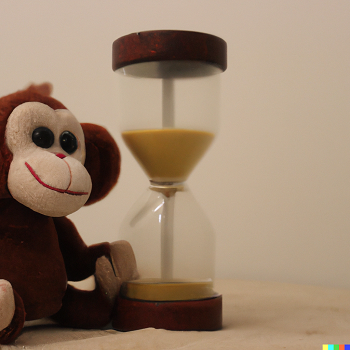The Three Ts of Empowerment
 If you give a person the tools, time, and training, you’ve empowered them. They know what to do, they have supporting materials, and they have the permission to spend the time they need to get it done.
If you give a person the tools, time, and training, you’ve empowered them. They know what to do, they have supporting materials, and they have the permission to spend the time they need to get it done.
If you give a person the tools and the time but not the training, they will struggle to figure out the tools but they’ll likely get there in the end. It won’t be all that efficient, but because you’ve given them the time they’ll be able to figure out the tools and get it done.
If you give a person the time but not the tools or the training, they’ll go on a random walk and make no progress. Yes, you’ve given them the time, but you’ve given them no real support or guidance. They’ll likely become tired and frustrated and you’ll have allocated their time yet made no progress.
If you give a person the tools and training but not the time, you’ve demoralized them. They have new skills and new tools and want to use them, but they’re too busy doing their day job. This is the opposite of empowerment.
If you’re not willing to give people the time to do new work, don’t bother providing new tools, and don’t bother training them. Stay the course and accept things as they are. Otherwise, you’ll disempower your best people.
But if you want to empower people, give them all three – tools, time, and training.
Image credit — Paul Balfe
Do you create the conditions for decisions to be made without you?
 What does your team do when you’re not there? Do they make decisions or wait for you to come back so you can make them?
What does your team do when you’re not there? Do they make decisions or wait for you to come back so you can make them?
If your team makes an important decision while you’re out of the office, do you support or criticize them? Which response helps them stand taller? Which is most beneficial to the longevity of the company?
If other teams see your team make decisions while you are on vacation, doesn’t that make it easier for those other teams to use their good judgment when their leader is on vacation?
If a team waits for their leader to return before making a decision, doesn’t that slow progress? Isn’t progress what companies are all about?
When you’re not in the office, does the organization reach out directly to your team directly? Or do they wait until they can ask your permission? If they don’t reach out directly, isn’t that a reflection on you as the leader? Is your leadership helping or hindering progress? How about the professional growth of your team members?
Does your team know you want them to make decisions and use their best judgment? If not, tell them. Does the company know you want them to reach out directly to the subject matter experts on your team? If not, tell them.
If you want your company to make progress, create the causes and conditions for good decisions to be made without you.
Image credit – Conall
Playing Tetris With Your Project Portfolio
 When planning the projects for next year, how do you decide which projects are a go and which are a no? One straightforward way is to say yes to projects when there are resources lined up to get them done and no to all others. Sure, the projects must have a good return on investment but we’re pretty good at that part. But we’re not good at saying no to projects based on real resource constraints – our people and our budgets.
When planning the projects for next year, how do you decide which projects are a go and which are a no? One straightforward way is to say yes to projects when there are resources lined up to get them done and no to all others. Sure, the projects must have a good return on investment but we’re pretty good at that part. But we’re not good at saying no to projects based on real resource constraints – our people and our budgets.
It’s likely your big projects are well-defined and well-staffed. The problem with these projects is usually the project timeline is disrespectful of the work content and the timeline is overly optimistic. If the project timeline is shorter than that of a previously completed project of a similar flavor, with a similar level of novelty and similar resource loading, the timeline is overly optimistic and the project will be late.
Project delays in the big projects block shared resources from moving onto other projects within the appropriate time window which cascades delays into those other projects. And the project resources themselves must stay on the big projects longer than planned (we knew this would happen even before the project started) which blocks the next project from starting on time and generates a second set of delays that rumble through the project portfolio. But the big projects aren’t the worst delay-generating culprits.
The corporate initiatives and infrastructure projects are usually well-staffed with centralized resources but these projects require significant work from the business units and is an incremental demand for them. And the only place the business units can get the resources is to pull them off the (too many) big projects they’ve already committed to. And remember, the timelines for those projects are overly optimistic. The big projects that were already late before the corporate initiatives and infrastructure projects are slathered on top of them are now later.
Then there are small projects that don’t look like they’ll take long to complete, but they do. And though the project plan does not call for support resources (hey, this is a small project you know), support resources are needed. These small projects drain resources from the big projects and the support resources they need. Delay on delay on delay.
Coming out of the planning process, all teams are over-booked with too many projects, too few resources, and timelines that are too short. And then the real fun begins.
Over the course of the year, new projects arise and are started even though there are already too few resources to deliver on the existing projects. Here’s a rule no one follows: If the teams are fully-loaded, new projects cannot start before old ones finish.
It makes less than no sense to start projects when resources are already triple-double booked on existing projects. This behavior has all the downside of starting a project (consumption of resources) with none of the upside (progress). And there’s another significant downside that most don’t see. The inappropriate “starting” of the new project allows the company to tell itself that progress is being made when it isn’t. All that happens is existing projects are further starved for resources and the slow pace of progress is slowed further.
It’s bad form to play Tetris with your project portfolio.
Running too many projects in parallel is not faster. In fact, it’s far slower than matching the projects to the resources on-hand to do them. It’s essential to keep in mind that there is no partial credit for starting a project. There is 100% credit for finishing a project and 0% credit for starting and running a project.
With projects, there are two simple rules. 1) Limit the number of projects by the available resources. 2) Finish a project before starting one.
Image credit – gerlos
When there are teaching moments, what do you teach?
 When you have something special but don’t know it, the Universe is there to take it away from you so you can appreciate what you no longer have. Seems backward, but the Universe knows how to be a good teacher.
When you have something special but don’t know it, the Universe is there to take it away from you so you can appreciate what you no longer have. Seems backward, but the Universe knows how to be a good teacher.
When someone asks you to help them, but you know they are asking for the wrong thing, what do you do? Do you feel pressure to maintain a good working relationship? Do you suggest something different? Or do you simply decline to help? What would the Universe do? It would probably play the long game.
When a team does not follow good practice even though they have the tools, talent, and time, and then asks you to do that very work, what do you do? Do you do the work they should have done? Do you suggest they allocate their resources to the problem? Do you ask them why they didn’t do the right work in the first place? What would the Universe do? Would do a little bit of everything. What would it want that team to learn?
When there’s disagreement on the approach, there can be no agreement on lower-level elements of the work. What do you do? Flip a coin? Arm wrestle? Yell at each other? I think the Universe would want to understand the design space in the most effective way, and I think it would try all the coherent approaches in a small way and see what happens. Then, it would ask everyone to get back together to review the results and decide what to do next.
There are teaching moments every day. But it’s never clear what to teach. Does the urgency and significance of the moment mean that the immediate problem should be solved and the teaching should wait until the next time? Is the teaching that the higher-level systemic problem is so significant that the short-term pain must be experienced to create momentum around solving the systemic problem? Is the teaching that the team should be given help in a way that preserves their emotional well-being so they can finish the project in good spirits and help them elevate their work next time?
With teaching moments there are no right answers. Sometimes you take the opportunity to teach and sometimes you look the other way. Sometimes you hold people accountable and sometimes you soothe egos. Sometimes you withhold resources and sometimes you jump in with both feet.
And like the Universe, you get better at teaching the more you do it.
Image credit — Andrew Kuznetsov
The Next Evolution of Your Success
 New ways to work are new because they have not been done before.
New ways to work are new because they have not been done before.
How many new ways to work have you demonstrated over the last year?
New customer value is new when it has not been shown before.
What new customer value have you demonstrated over the last year?
New ways to deliver customer value are new when you have not done it that way before.
How much customer value have you demonstrated through non-product solutions?
The success of old ways of working block new ways.
How many new ways to work have been blocked by your success?
The success of old customer value blocks new customer value.
How much new customer value has been blocked by your success with old customer value?
The success of tried and true ways to deliver customer value blocks new ways to deliver customer value.
Which new ways to deliver unique customer value have been blocked by your success?
Might you be more successful if you stop blocking yourself with your success?
How might you put your success behind you and create the next evolution of your success?
Image credit — Andy Morffew
When you say yes to one thing, you say no to another.
 Life can get busy and complicated, with too many demands on our time and too little time to get everything done. But why do we accept all the “demands” and why do we think we have to get everything done? If it’s not the most important thing, isn’t a “demand for our time” something less than a demand? And if some things are not all that important, doesn’t it say we don’t have to do everything?
Life can get busy and complicated, with too many demands on our time and too little time to get everything done. But why do we accept all the “demands” and why do we think we have to get everything done? If it’s not the most important thing, isn’t a “demand for our time” something less than a demand? And if some things are not all that important, doesn’t it say we don’t have to do everything?
When life gets busy, it’s difficult to remember it’s our right to choose which things are important enough to take on and which are not. Yes, there are negative consequences of saying no to things, but there are also negative consequences of saying yes. How might we remember the negative consequences of yes?
When you say to yes to one thing, you say no to the opportunity to do something else. Though real, this opportunity cost is mostly invisible. And that’s the problem. If your day is 100% full of meetings, there is no opportunity for you to do something that’s not on your calendar. And in that moment, it’s easy to see the opportunity cost of your previous decisions, but that doesn’t do you any good because the time to see the opportunity cost was when you had the choice between yes and no.
If you say yes because you are worried about what people will think if you say no, doesn’t that say what people think about you is important to you? If you say yes because your physical health will improve (exercise), doesn’t that say your health is important to you? If you say yes to doing the work of two people, doesn’t it say spending time with your family is less important?
Here’s a proposed system to help you. Open your work calendar and move one month into the future. Create a one-hour recurring meeting with yourself. You just created a timeslot where you said no in the future to unimportant things and said yes in the future to important things. Now, make a list of three important things you want to do during those times. And after one month of this, create a second one-hour recurring meeting with yourself. Now you have two hours per week where you can prioritize things that are important to you. Repeat this process until you have allocated four hours per week to do the most important things. You and stop at four hours or keep going. You’ll know when you get the balance right.
And for Saturday and Sunday, book a meeting with yourself where you will do something enjoyable. You can certainly invite family and/or friends, but it the activity must be for pure enjoyment. You can start small with a one-hour event on Saturday and another on Sunday. And, over the weeks, you can increase the number and duration of the meetings.
Saying yes in the future to something important is a skillful way to say no in the future to something less important. And as you use the system, you will become more aware of the opportunity cost that comes from saying yes.
Image credit – Gilles Gonthier
Is the timing right?
 If there is no problem, it is too soon for a solution.
If there is no problem, it is too soon for a solution.
But when there is consensus on a problem, it may be too late to solve it.
If a powerful protector of the Status Quo is to retire in a year, it may be too early to start work on the most important sacrilege.
But if the sacrilege can be done under cover, it may be time to start.
It may be too soon to put a young but talented person in a leadership position if the team is also green.
But it may be the right time to pair the younger person with a seasoned leader and move them both to the team.
When the business model is highly profitable, it may be too soon to demonstrate a more profitable business model that could obsolete the existing one.
But new business models take a long time to gestate and all business models have half-lives, so it may be time to demonstrate the new one.
If there is no budget for a project, it is too soon for the project.
But the budget may never come, so it is probably time to start the project on the smallest scale.
When the new technology becomes highly profitable, it may be too soon to demonstrate the new technology that makes it obsolete.
But like with business models, all technologies have half-lives, so it may be time to demonstrate the new technology.
The timing to do new work or make a change is never perfect. But if the timing is wrong, wait. But don’t wait too long.
If the timing isn’t right, adjust the approach to soften the conflict, e.g., pair a younger leader with a seasoned leader and move them both.
And if the timing is wrong but you think the new work cannot wait, start small.
And if the timing is horrifically wrong, start smaller.
When You Have Enough…
 When you have enough, you have plenty to give to others.
When you have enough, you have plenty to give to others.
And when you give to others, they remember.
When you have enough, you can be happy with things as they are.
And when you are happy with things as they are, people like to be around you.
When you have enough, there’s no need to take.
And when you don’t take, there’s more for others.
When you have enough, you don’t strive for more.
And when you don’t strive, it’s easier to do what’s right.
When you forget you have enough, tell yourself you have enough.
And when you tell yourself you have enough, you end up remembering you have enough.
When you have enough, there is less stress.
And when there’s less stress, you have more energy to apply in skillful ways.
When you have enough, it’s because you’ve decided you have enough.
Why not decide you have enough?
Image credit — Nenad Stojkovik
If you want to change things, do a demo.
 When you demo something new, you make the technology real. No longer can they say – that’s not possible.
When you demo something new, you make the technology real. No longer can they say – that’s not possible.
When you demo something new, you help people see what it is and what it isn’t. And that brings clarity.
When you demo something new, people take sides. And that says a lot about them.
When you demo something new, be prepared to demo it again. It takes time for people to internalize new concepts.
When someone asks you to repeat the demo so others can see it, it’s a sign there’s something interesting about the demo. Repeat it.
When someone calls out fault with a minor element of the demo, they also reinforce the strength of the main elements.
When you demo something new and it works perfectly, you should have demo’d it sooner.
When the demo works perfectly, you’re not trying hard enough.
When you demo something new, there is no way to predict the action items spawned by the demo. In fact, the reason to do the demo is to learn the next action items.
When you demo something new, make the demo short so the conversation can be long.
When you demo something new, shut your mouth and let the demo do the talking.
When you demo something new, keep track of the questions that arise. Those questions will inform the next demo.
When you demo something new and it’s misunderstood, congratulations. You’ve helped the audience loosen their thinking.
If you want to change people’s thinking, do a demo.
Image credit – Ralf Steinberger
Overcoming Not Invented Here (NIH), The Most Powerful Blocker of Innovation
 When new ideas come from the outside, they are dismissed out of hand. The technical term for this behavior is Not Invented Here (NIH). Because it was not invented by the party with official responsibility, that party stomps it into dust. But NIH doesn’t stomp in public; it stomps in mysterious ways.
When new ideas come from the outside, they are dismissed out of hand. The technical term for this behavior is Not Invented Here (NIH). Because it was not invented by the party with official responsibility, that party stomps it into dust. But NIH doesn’t stomp in public; it stomps in mysterious ways.
Wow! That’s a great idea! Then, mysteriously, no progress is made and it dies a slow death.
That’s cool! Then there’s a really good reason why it can’t be worked.
That’s interesting! Then that morphs into the kiss of death.
We never thought of that. But it won’t scale.
That’s novel! But no one is asking for it.
That’s terribly exciting! We’ll study it into submission.
That’s incredibly different! And likely too different.
When the company’s novel ideas die on the vine, they likely die at the hands of NIH. If you can’t understand why a novel idea never made it out of the lab, investigate the crime scene and you may find NIH’s fingerprints. If customers liked the new idea yet it went nowhere, it could be NIH was behind the crime. If it makes sense, but it doesn’t make progress, NIH is the prime suspect.
If a team is not receptive to novel ideas from the outside, it’s because they consider their own ideas sufficiently good to meet their goals. Things are going well and there’s no reason to adopt new ideas from the outside. And buried in this description are the two ways to overcome NIH.
The fastest way to overcome NIH is to help a new idea transition from an idea conceived by someone outside the team to an idea created by someone inside the team. Here’s how that goes. The idea is first demonstrated by the external team in the form of a functional prototype. This first step aims to help the internal team understand the new idea. Then, the first waiting period is endured where nothing happens. After the waiting period, a somewhat different functional prototype is created by the external team and shown to the internal team. The objective is to help the internal team understand the new idea a little better. Then, the second waiting period is endured where nothing happens. Then, a third functional prototype is created and shown to the internal team. This time, shortcomings are called out by the external team that can only be addressed by the internal team. Then, the last waiting period is endured. Then, after the third waiting period, the internal team addresses the shortcomings and makes the idea their own. NIH is dead, and it’s off to the races.
The second fastest way to overcome NIH is to wait for the internal team to transition to a team that is receptive to new ideas initiated outside the team. The only way for a team to make the transition is for them to realize that their internal ideas are insufficient to meet their objectives. This can only come after their internal ideas are shown to be inadequate multiple times. Only after exhausting all other possibilities, will a team consider ideas generated from outside the team.
When the external team recognizes the internal team is out of ideas, they demonstrate a functional prototype to the internal team. And they do it in an “informational” way, meaning the prototype is investigatory in nature and not intended to become the seed of the internal team’s next generation platform. And as it turns out, it’s only a strange coincidence that the functional prototype is precisely what the internal team needs to fuel the next-generation platform. And the prototype is not fully wrung out. And as it turns out, the parts that need to be wrung out are exactly what the external team knows how to do. And when the internal team needs expertise from the external team to address the novel elements, as it turns out the external team conveniently has the time to help out.
Not Invented Here (NIH) is real. And it’s a powerful force. And it can be overcome. And when it is overcome, the results are spectacular.
Image credit — Becky Mastubara
Bucking The Best Practice
 Doing what you did last works well, right up until it doesn’t.
Doing what you did last works well, right up until it doesn’t.
When you put 100% effort into doing what you did last time and get 80% of the output of last time, it’s time to do something different next time.
If it worked last time, but the environment or competition has changed, chances are it won’t work this time.
You can never step in the same river twice, and it’s the same with best practices.
Doing what you did last time is predictable until it isn’t.
The cost of trying the same thing too often is the opportunity cost of unlearned learning, which only comes from doing new things in new ways.
Our accounting systems don’t know how to capture the lost value due to unlearned learning, but your competition does.
Doing what you did last time may be efficient, but that doesn’t matter when it becomes ineffective.
Without new learning, you have a tired business model that will give you less year on year.
If you do what you did last time, you slowly learn what no longer works, but that’s all.
The best practice isn’t best when the context is different.
It’s not okay to do what you did last time all the time.
If you always do what you did last time, you don’t grow as a person.
If you do what you did last time, there are no upside surprises but there may be downside surprises.
Doing what you did last time is bad for your brain and your business.
How much of your work is repeating what you did last time? And how do you feel about that?
If you are tired of doing what you did last time, what are you going to do about it?
Might you sneak in some harmless novelty when no one is looking?
Might you conspire to try something new without raising the suspicion of the Standard Work Police?
Might you run a small experiment where the investment is small but the learning could be important?
Might you propose trying something new in a small way, highlighting the potential benefit and the safe-to-fail nature of the approach?
Might you propose small experiments run in parallel to increase the learning rate?
Might you identify an important problem that has never been solved and try to solve it?
Might you come up with a new solution that radically grows company profits?
Might you create a solution that obsoletes your company’s most profitable offering?
Might you bring your whole self to your work and see what happens?
Image credit – Marc Dalmulder
 Mike Shipulski
Mike Shipulski